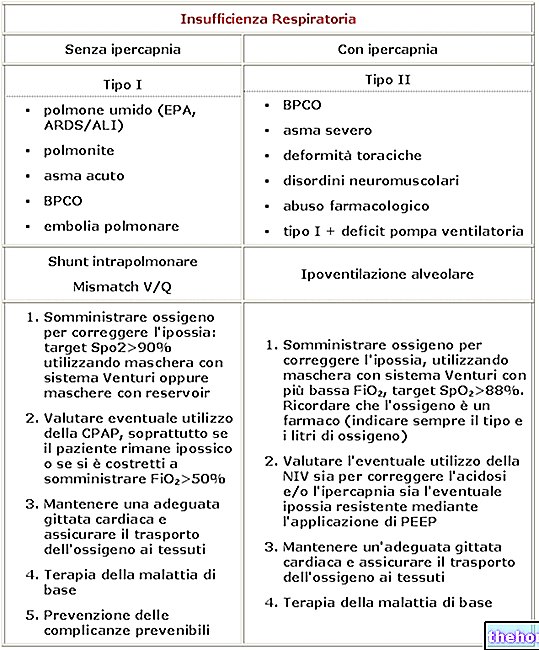Definition of pneumothorax
Acronyms of PNX, pneumothorax is a benign pathological condition in which the presence of gas is recorded inside the pleural cavity. In other words, pneumothorax is an expression of an abnormal accumulation of air inside the space that separates the lung from the chest wall. A similar condition can cause serious breathing problems: by exerting a marked pressure on the lung, the air accumulated in situ prevents it from expanding normally, thus causing dyspnea and pain during the respiratory act.
To understand...
Under physiological conditions, lower pressure is exerted on the outer surfaces of the lungs than atmospheric pressure. In this way, the lung is perfectly capable of fulfilling its function. In the case of pneumothorax, this pressure difference is absent, therefore the elastic feedback of the lung is favored; failing to expand, the lung is bound to collapse on itself (like a punctured balloon)
- The air that has entered the pleural cavity hinders the adhesion between the lung and the internal thoracic walls. By retracting, the lung reduces its volume and causes dyspnea.
Causes
Pneumothorax recognizes various causes and it is precisely on the basis of the triggering agent that different pathological forms can be identified:
- Spontaneous pneumothorax: lung collapse appears suddenly, without a precise and observable reason. Spontaneous pneumothorax is divided into two variants: primary and secondary. The primary (or primitive) form begins in young subjects without any underlying lung disorder; the secondary variant, on the other hand, occurs when a patient has severe pulmonary dysfunction, and represents a more serious condition than the previous one.
- Traumatic pneumothorax: the pathology is the result of traumatic injuries, such as gunshots to the chest, back stabbings, rib fractures or surgical errors. The disease takes on the connotation of hemo-pneumothorax when blood accumulates in the pleural cavity in addition to gas.
- Iatrogenic pneumothorax: direct expression of invasive therapeutic / diagnostic maneuvers, such as pleural biopsy, central venous catheterization and trans-thoracic needle aspiration.
It has been observed that pneumothorax occurs more frequently among young males, especially if they are long-limbed. However, other risk factors that predispose a person to the onset of this lung disease have also been identified.
The main predisposing factors for pneumothorax are listed below:
- Acute asthma
- COPD (Chronic Obstructive Pulmonary Disease)
- Lung cancer
- Emphysema
- Cystic fibrosis
- Idiopathic pulmonary fibrosis
- Lung infections (caused by bacteria or parasites)
- Histiocytosis (abnormal and uncontrolled proliferation of histiocytes in the blood and tissues, responsible for cancer)
- Connective tissue disorders (e.g. Marfan syndrome, rheumatoid arthritis, ankylosing spondylitis)
- Whooping cough
- Sarcoidosis
- Sarcoma
- smoking
- Tuberculosis
Incidence
From the medical statistics, interesting results have emerged regarding the incidence of pneumothorax. It is estimated that the spontaneous variant of the disease occurs more frequently in boys from the age of 20, while the forty-year-olds are only rarely affected; the statistics instead report different data regarding secondary spontaneous pneumothorax: in this case, the target is made up of men aged between 60 and 65 years.
It is estimated that 18 males per 100,000 men are affected by pneumothorax annually. As for the female sex, it is observed that every year only 6 women out of 100,000 complain of this discomfort.
Another element analyzed by the statesmen is the frequency with which pneumothorax occurs in a relapsing form. It is believed that 30% of patients admitted for primary spontaneous pneumothorax will re-suffer from the same problem within 6 months to 3 years of the first acute episode. Secondary spontaneous pneumothorax, on the other hand, recurs in 45% of affected patients. The risk of relapse seems to increase with aging, with smoking and in the presence of pulmonary fibrosis.
Furthermore, in the case of AIDS and COPD, the risk of pneumothorax relapse and poor prognosis increases exaggeratedly.
- Quitting smoking minimizes the risk of relapse
Symptoms
Symptoms accompanying pneumothorax can be vague and dubious, especially in mild forms. In the more severe variants, however, the prodrome can be particularly pronounced: in such situations, pneumothorax constitutes a "medical emergency in all respects.
Symptoms that characterize most forms of pneumothorax are: dyspnea, hypoxia, chest and intrascapular pain (perceived as a sort of vibration or crepitus during inhalation). Depending on the severity of the condition, the affected patient may also complain of fatigue. , change in blood pressure, cyanosis (due to lack of oxygen), pain in the carotid artery, paraesthesia in the legs, arms and mouth, chest tightness, tachycardia and dizziness.
Diagnosis
Often times, simple physical examination is not sufficient to confirm the diagnosis of pneumothorax. CT (computed tomography) or chest radiography are generally the two most commonly used diagnostic techniques for confirming the disease.
- A differential diagnosis should be made with pleural effusion, simple chest pain and pulmonary embolism
Treatment
The goal of treatment for pneumothorax is to relieve the pressure exerted on the lung in order to ensure its re-expansion. The choice of one treatment option over another depends on the form in which the disease occurs.
Not all variants of pneumothorax require immediate medical treatment. When it starts asymptomatically, the pneumothorax tends to resolve spontaneously over a period of about ten days. A similar therapeutic approach can only be considered in the absence of underlying serious lung lesions. Even when only one portion of the lung has collapsed, the doctor can choose not to subject the patient to any invasive treatment; however, the monitoring of the patient is essential.
Different speech must be addressed for the more aggressive variants: in similar circumstances, the patient undergoes chest drainage. This medical practice consists in inserting a hollow needle or a tube between the ribs, precisely in the pleural space filled with air that presses on the collapsed lung. The tube is connected to an aspiration system capable of constantly removing the air accumulated in situ . This particular device can be removed after a few hours or a few days, depending on the severity of the condition.
Surgery can be recommended both when drainage has not brought satisfactory results, and as a precautionary form to avoid the onset of relapses:
- Pleurodesis: pulmonary adhesion to the chest wall is favored. Pleurodesis can be surgical (full-fledged surgery) or medical (instillation of sclerosing drugs through a pleural catheter)
- Pleurectomy: partial removal of the parietal pleura
There is no way to avoid pneumothorax; however, quitting smoking can significantly reduce the chances of relapse.




























